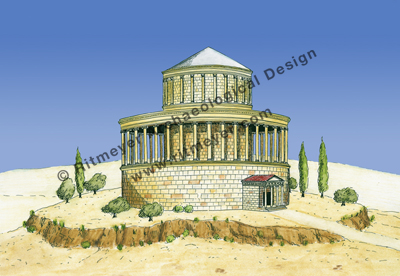Haaretz newspaper carried an article today by Nir Hasson, reporting on the seventh annual conference, “Innovations in Archaeology in Jerusalem and the Surrounding Area”.
During that conference, two archaeologists, Joseph Patrich and Benny Arubas challenged Ehud Netzer’s identification of Herod’s Tomb that was found at Herodium near Bethlehem.

They argued that the tomb was too small for the larger than life personality of Herod the Great and that the monument was not in keeping with the size of other Herodian constructions. They also found the sarcophagus, which was made of beautiful red limestone, to be of inferior quality for the king and had expected either a marble or golden one. They also said that the plaza near the tomb was too small to accommodate the many people that accompanied the sarcophagus of Herod the Great.
Patrich emphasizes that he was a student of Ehud Netzer, but that he couldn’t agree with him on the identification of the tomb.
The rebuttal delivered by Roi Porat, who succeeded Netzer as the head of the Herodium excavations, was more positive and convincing. Porat pointed out that there was a very large plaza at the foot of the artificial man-made hill that could easily accommodate the funeral procession. He also noted that the tomb stood on natural ground:
“This whole big mass has one place that was not covered in earth, and that is the site of the tomb,” Porat says. He claims that Herod conceived of the entire tel as an enormous and unique burial mound, symbolizing the idea that life at its top would go on even after the king was buried.”
Porat doesn’t rule out the possibility of finding other tombs, but this one appears from an architectural perspective more than qualify to be the tomb in which Herod the Great was buried.
Porat rightly observed:
“We believe we have a decent picture of what is going on there and it is convincing. We have sufficient data. He [Patrich] deals with what is not, and we with what is”.
That would fit in with my personal experience. Patrich may be proud to have been one of Netzer’s students, but having worked with him on several projects in the past, I must say that I am not too impressed with Patrich’s knowledge of ancient architecture.
Patrich may have expected Herod’s tomb to have been a much larger and more impressive monument, but this exquisitively designed tomb was built for Herod himself and a few close family members only. Patrich and Arubas must have forgotten that a very large funerary monument for Herod’s wider family had already been identified by Ehud Netzer north of Jerusalem:

Herod was buried in his private tomb in Herodium, both other members of his family were probably buried in this structure. This mausoleum is mentioned twice by Josephus, in War 5.108 and 5.507.
Haaretz may have called the observations of Patrich and Arubas an “archaeological stunner”, but I am not convinced by them. See also Todd Bolen’s blog.
HT: Joseph Lauer

2 thoughts on “Herod’s Tomb at Herodium”